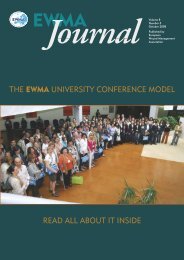best practice for the management of lymphoedema ... - EWMA
best practice for the management of lymphoedema ... - EWMA
best practice for the management of lymphoedema ... - EWMA
You also want an ePaper? Increase the reach of your titles
YUMPU automatically turns print PDFs into web optimized ePapers that Google loves.
ASSESSMENT<br />
FIGURE 3 Method <strong>for</strong> obtaining measurements <strong>for</strong> calculating limb volume<br />
A pretensioned tape measure should be used. No tension should be applied to <strong>the</strong> tape during measuring.<br />
Upper limbs<br />
■ Ask <strong>the</strong> patient to sit with <strong>the</strong> arm supported on a table with <strong>the</strong> hand palm down<br />
■ On <strong>the</strong> ulnar aspect <strong>of</strong> <strong>the</strong> arm* measure with a ruler and record <strong>the</strong> distance from <strong>the</strong><br />
nail bed <strong>of</strong> <strong>the</strong> little finger to 2cm above <strong>the</strong> ulnar styloid (wrist)†. Mark this point on<br />
<strong>the</strong> patient. This determines <strong>the</strong> starting point<br />
■ Mark <strong>the</strong> same point on <strong>the</strong> contralateral arm<br />
■ Lie a ruler along <strong>the</strong> ulnar aspect <strong>of</strong> <strong>the</strong> arm and mark <strong>the</strong> limb at 4cm intervals from<br />
<strong>the</strong> starting point to 2cm below <strong>the</strong> axilla<br />
■ With <strong>the</strong> limb in a relaxed position, measure <strong>the</strong> circumference at each mark, placing<br />
<strong>the</strong> top edge <strong>of</strong> <strong>the</strong> tape measure just below <strong>the</strong> mark<br />
■ Note measurements above <strong>the</strong> elbow in <strong>the</strong> correct section <strong>of</strong> <strong>the</strong> paper or electronic<br />
recording <strong>for</strong>m<br />
■ Repeat <strong>the</strong> process on <strong>the</strong> o<strong>the</strong>r limb. Ensure <strong>the</strong>re are <strong>the</strong> same number <strong>of</strong><br />
measurements <strong>for</strong> both arms<br />
■ Document <strong>the</strong> position <strong>the</strong> patient was in when measurements were taken<br />
ASSESSMENT<br />
Lower limbs<br />
■ Ask <strong>the</strong> patient to stand or sit with both feet firmly on <strong>the</strong> ground<br />
■ On <strong>the</strong> medial aspect <strong>of</strong> <strong>the</strong> leg* measure with a ruler and record <strong>the</strong> distance from <strong>the</strong> floor to 2cm above <strong>the</strong> middle <strong>of</strong> <strong>the</strong> medial<br />
malleolus†. Mark this point on <strong>the</strong> patient. This determines <strong>the</strong> starting point<br />
■ Mark <strong>the</strong> same point on <strong>the</strong> contralateral leg<br />
■ Seat patient on a chair with bottom as close to <strong>the</strong> edge as possible, or seat on a couch with <strong>the</strong> leg straight<br />
■ Lie a ruler along <strong>the</strong> medial aspect <strong>of</strong> <strong>the</strong> leg and mark <strong>the</strong> limb at 4cm<br />
intervals from <strong>the</strong> starting point to 2cm below <strong>the</strong> popliteal fossa <strong>for</strong> swelling<br />
below <strong>the</strong> knee<br />
■ If swelling extends above <strong>the</strong> knee, ask <strong>the</strong> patient to stand or to lie on a couch.<br />
Continue <strong>the</strong> marks at 4cm intervals above <strong>the</strong> knee to 2cm below <strong>the</strong> gluteal<br />
crease<br />
■ With <strong>the</strong> limb in a relaxed position, measure <strong>the</strong> circumference at each mark,<br />
placing <strong>the</strong> top edge <strong>of</strong> <strong>the</strong> tape measure just below <strong>the</strong> mark<br />
■ Note measurements above <strong>the</strong> knee in <strong>the</strong> correct section <strong>of</strong> <strong>the</strong> paper or<br />
electronic recording <strong>for</strong>m<br />
■ Repeat <strong>the</strong> process on <strong>the</strong> o<strong>the</strong>r limb. Ensure <strong>the</strong>re are <strong>the</strong> same number <strong>of</strong><br />
measurements <strong>for</strong> both legs<br />
■ Document <strong>the</strong> position <strong>the</strong> patient was in when measurements were taken<br />
*If only one limb is affected, start with <strong>the</strong> unaffected side.<br />
†If <strong>the</strong> ulnar styloid or medial malleolus cannot be located, alternative fixed anatomical points can be used to determine <strong>the</strong> starting point, eg olecranon process or<br />
anterior iliac spine. The distance from <strong>the</strong> fixed anatomical point to <strong>the</strong> starting point should be recorded to ensure consistency when measurements are repeated<br />
subsequently.<br />
NB Some limb volume calculation methods or systems may require a different interval between circumferential measurements.<br />
MEASURING LIMBS FOR VOLUME OR COMPRESSION GARMENTS<br />
Figures 3 and 4 illustrate methods <strong>for</strong> measuring limbs to assess limb volume and swelling.<br />
These methods differ from <strong>the</strong> techniques used to measure <strong>for</strong> compression garments,<br />
which are shown on pages 41 and 42.<br />
BEST PRACTICE FOR THE MANAGEMENT OF LYMPHOEDEMA 11

















